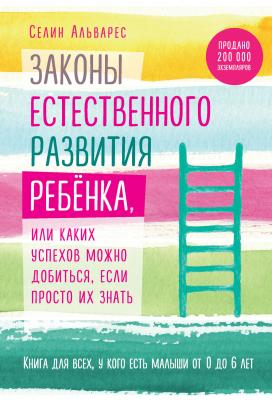Законы естественного развития ребенка, или Каких успехов можно добиться, если просто их знать. Селин Альварес
Читать онлайн.| Название | Законы естественного развития ребенка, или Каких успехов можно добиться, если просто их знать |
|---|---|
| Автор произведения | Селин Альварес |
| Жанр | Зарубежная прикладная и научно-популярная литература |
| Серия | Психологический бестселлер (Эксмо) |
| Издательство | Зарубежная прикладная и научно-популярная литература |
| Год выпуска | 2016 |
| isbn | 978-5-04-092460-8 |
26
Gopnik, A. (2010), Le Bébé philosophe (Младенец-философ), Le Pommier.
27
Dehaene, S. (17 février 2015), «Fondements cognitifs des apprentissages scolaires. La mémoire et son optimisation» (Когнитивная база школьного обучения. Память и ее оптимизация), лекция в Коллеж де Франс.
28
Эндогенный – тот, который продуцируется самой структурой в отличие от экзогенного, обусловленного привнесением извне.
29
Freeman, S., Eddy, S.L., McDonough, M., Smith, M.K., Okoroafor, N., Jordt, H. & Wenderoth, M.P. (2014), «Active Learning Increases Student Performance in Science, Engineering, and Mathematics», PNAS, 111 (23), стр. 8410–8415.
30
Mayer, R.E. (2004), «Should There Be a Three-Strikes Rule Against Pure Discovery Learning? The Case for Guided Methods of Instruction», The American Psychologist, 59 (1), стр. 14–19.
31
Baldwin, D.A., Markman, E.M., Bill, B., Desjardins, R.N., Irwin, J. – M. & Tidball, G. (1996), «Infants’ Reliance on a Social Criterion for Establishing Word-Object Relations», Child Development, 67 (6), стр. 3135–3153.
32
Kuhl, P.K., Tsao, F.M. & Liu, H.M. (2003), «Foreign-Language Experience in Infancy: Effects of Short-Term Exposure and Social Interaction on Phonetic Learning», Proc Natl Acad Sci USA, 100 (15), стр. 9096—101.
33
«Les secrets du cerveau des bébés» (Тайны мозга ребенка), см. выше.
34
Tenenbaum, E.J., Sobel, D.M., Sheinkopf, S.J., Malle, B.F. & Morgan, J.-L. (2015), «Attention to the Mouth and Gaze Following in Infancy Predict Language Development», J Child Lang., 18, стр. 1—18; Carpenter, M., Nagell, K. & Tomasello, M. (1998), «Social Cognition, Joint Attention, and Communicative Competence From 9 to 15 Months of Age», Monogr Soc Res Child Dev., 63 (4), стр. i-vi, 1—143.
35
Gopnik A., Meltzoff A. & Kuhl P. (2005), Comment pensent les bébés? (Как думают маленькие дети?), см. выше, стр. 277.
36
Desmurget M. (2012), TV lobotomie, Max Milo.
37
Csibra, G. & Gergely, G. (2009), «Natural Pedagogy», Trends Cogn Sci, 13 (4), стр. 148–153.
38
Howe, N., Della Porta, S., Recchia, H., Funamoto, A. & Ross, H. (2015), «“This Bird Can’t Do It ‘cause this Bird Doesn’t Swim in Water”: Sibling Teaching during Naturalistic Home Observations in Early Childhood», Journal of Cognition and Development, 16 (2), стр. 314–332.
39
Усвоение в ближайшей зоне развития ребенка не может происходить без посторонней помощи.
40
Фундаментальные компетенции, так называемые «исполнительные». Мы поговорим о них в третьей части книги.
41
Мотивация, исходящая от организма, внутренний спонтанный порыв.
42
Rescorla, R. A. & Wagner, A. R. (1972), A theory of Pavlovian conditioning: Variations in the effectiveness of reinforcement and nonreinforcement, Classical Conditioning II, Current Research and Theory (Eds Black AH, Prokasy WF), Appleton Century Crofts, стр. 64–99.
43
Donato, F., Rompani, S.B. & Caroni, P. (2013), «Parvalbumin Expressing Basketcell Network Plasticity Induced by Experience Regulates Adult Learning», Nature, 504 (7479), стр. 272–276.
44
Hanscom A., «The Unsafe Child: Less Outdoor Play is Causing More Harm than Good», статья от 6 мая 2015 г. для ассоциации Children & Nature Network.
45
Информационные и коммуникационные технологии: Интернет, компьютеры, планшеты и т. д.
46
Pyle, R.M. (2001), The Rise and Fall of Natural History, Orion.
47
D’Amore, C., Charles, C. & Louv, R. (2015), «Thriving Through Nature: Fostering Children’s Executive Function Skills», Children & Nature Network; Fjørtoft, I. (2001), «The Natural Environment as a Playground for Children: The Impact of Outdoor Play Activities in Pre-Primary School Children», Early Childhood Education Journal, 29 (2); Louv, R. (2008, 2005), Last Child in the Woods: Saving Our Children from Nature-Deficit Disorder, Chapel Hill, Algonquin Books; Charles, C. & Louv, R. (2009), «Children’s Nature Deficit: What We Know – and Don’t Know», Children & Nature Network.
48
Gillet, T., «Une enfance plus simple pourrait protéger nos petits contre les troubles psychiques» (Самое простое детство может защитить малышей от психических нарушений), Huffington Post, 12 апреля 2016 г.
&nbs
